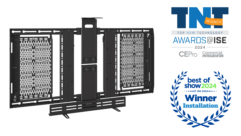AV Joins The Nuclear Waste Debate
Install adds AV capabilities to the Nuclear Regulatory Commission’s 8,000-square-foot Nevada hearing room.
CHALLENGE: Design and install a robust AV system capable of presenting the VGA-resolution content of an expansive digital evidence database, while simultaneously presenting the composite video of live testimony and allowing ample individual control for lawyers and judges.
SOLUTION: Expand an existing system already designed and installed for the same client, while accounting for unique challenges, such as state laws banning the use of unprotected wiring.
AS ROOMS designed for legal proceedings go, the Nuclear Regulatory Commission’s new public hearing facility in Las Vegas is probably as big and well equipped as they come.
The facility, which features an 8,000-square-foot room with 35-foot ceilings, was built last year for the sole purpose of hosting what promises to be one of the bigger public hearings in United States history. It’s here that Nuclear Regulatory Commission (NRC) officials will observe a vast array of evidence and testimony, as the Department of Energy seeks to gain authorization to build a massive repository for nuclear waste at Nevada’s Yucca Mountain, and myriad local public and private agencies seek to stop it.
“The NRC needed something that was bullet-proof,” explains Kevin Sandler, CEO and president of Phoenix-based systems integrator ExhibitOne Corp., which designed and installed the hearing room’s robust AV system “The last thing they need while overseeing one of the largest cases in U.S. history is for a piece of technology to let them down.”
Already under contract with the federal government to outfit the nation’s bankruptcy and district courts, ExhibitOne began working with the NRC in 2003, when it was brought in by Fairfax, VA-based Nortel Government Solutions (then known as PEC Solutions), the contractor that was installing a digital evidence database at the NRC’s Rockville, MD, headquarters.
“PEC Solutions heard about us through our federal contract with the Administrative Office of U.S. Courts,” explains Michael J. Lofaro, vice president of engineering for ExhibitOne. “We’ve done more than 450 courtrooms around the U.S.”
With the Rockville project deemed successful, the NRC awarded Nortel a new contract valued at $2.3 million to design and build a second evidence database system for its Las Vegas facility in 2004. And Nortel once again brought along ExhibitOne to design the AV system.
CLOSED CAPTIONING PROVIDED BY EXHIBITONE
With the Americans with Disabilities Act mandating — albeit in somewhat vague language — that public hearing rooms include closed captioning services for the hearing impaired, Phoenix-based systems integrator ExhibitOne designed such functionality into the presentation system of the Nuclear Regulatory Commission’s (NRC) Nevada hearing room.
The NRC’s hearing room employs an “online” captioning system, meaning it’s designed to add text captioning in real time to the live testimony occurring in the hearing room. All transcripts taken by the court stenographer are — in the form of RS232 serial data — fed into the digital evidence system, which stores this data and processes it into actual English using a custom programmed computer-aided-transcription (CAT) software.
The computer then outputs ASCII-formatted data — also via RS232 signal — to a Link Electronics PCE-845D closed captioning encoder, which embeds the captioning into the video signal. The captions are hidden on Line 21 of the vertical blanking interval (VBI) within this NTSC signal. In television terms, the VBI is the non-viewable portion of the video signal —occupying 45 of the total 525 lines per frame. This portion of NTSC was created so that traditional CRT monitors could reset their guns to the upper left corner of the monitor screen to begin painting the next frame.
The NRC’s closed captioning system uses a Link IEC-785 module to decode this captioning data so that it can be displayed. Because the captions are being input live, they scroll left to right at a rate of about two characters per frame.
According to ExhibitOne engineer Michael Lofaro, the system allows presentations of VGA-resolution evidence to include closed captioning — a trick that involves the melding of VGA and composite video images into the same picture.
“I hadn’t seen closed captioning put on a VGA image anywhere else before,” Lofaro says. “But I didn’t want to have to take digital evidence down to a composite video resolution in order to closed caption it.”
To make it work, ExhibitOne employed an RGB Spectrum DualView XL display processor ($6,495 MSRP), which allows computer and video sources to be simultaneously viewed on the same screen, with the images stretched, shaped, and moved around per operator discretion. “We were able to give the NRC what they were really asking for,” Lofaro adds.
“The Rockville hearing room has a system that’s basically identical to the one we have in Las Vegas, yet much smaller in scale,” notes Andy Welkie, digital data management systems project manager for the NRC. “The AV system is designed to be a subsystem to the digital evidence database. It allows us to bring in every document and testimony that’s presented, process it electronically, and then display it in the hearing room.”
Budgeted at about $1 million, the AV system in the NRC’s Las Vegas hearing room is designed to match the enormity of both the room and the proceedings. Fifteen attorney tables — each with two locations — are spread about the vast room, which also includes separate locations for three judges and five witnesses. The system also had to be designed to simultaneously display the VGA-resolution digital files stored in the evidence database and the composite video of live testimony.
“I’ve never done a courtroom before with this much equipment in it,” says Lofaro of an AV system that consumes four full Middle Atlantic ERK-4425 equipment racks in a control area tucked into the corner of the hearing room. “This is by far the most technologically advanced courtroom in the country.”
For Lofaro, just wiring everything together was tough enough. “In Nevada, the building code states that everything has to be in conduit, even low-voltage stuff,” he explains. “So we had to enclose everything.”
Lofaro’s team dealt with that issue by putting on its electrical contractor hats and running flexible conduit to all the attorney, judge, witness, and court-reporter work stations scattered about the massive room, and then connecting everything by running conduit beneath the room’s depressed slab.
Meanwhile, dealing with a security-sensitive government project involving nuclear waste presented other challenges. “Challenges exist in any government project we do,” Sandler notes. “Obviously, the NRC is very stringent when it comes to security issues, so they wanted to be aware of every aspect of the system we were putting in to make sure there weren’t potential points of security breach. There are good reasons for this, of course, but approvals took more time because they had to go through more layers. When you deal with the government, you need to come in with patience. And if you’re an integrator who’s more used to dealing with the commercial sector, you need to be aware of certain differences — it’s a bureaucratic machine, it’s just the way it works, and you need to be prepared for it to be slower and more cumbersome.”
Not only did ExhibitOne have to deal with the lag time it took to get approvals, it had to account for a building design for which it had no input. “They did a lot of things backward,” Lofaro explains. “For example, they got an acoustical consultant after the room was built.”
In virtually all cases, however, Lofaro and his team successfully designed around these challenges. For instance, original building specs called for 19 42-inch plasma displays to be hung from the room’s three-story-high, windowed ceiling. “But the room is actually near the airport, and whenever a plane flies over, everything in the building rattles and moves,” Lofaro says. “And it wouldn’t have looked right with all those plasmas there — it would have taken away from the grandness of the room.”
So instead of ceiling-suspended displays, ExhibitOne ultimately settled on a design built around four wall-mounted 61-inch NEC PlasmaSync 61XM2 monitors, which flank the room, two to a side. But the system — controlled for the most part via AMX interface in the master control room — is also designed to also emphasize individual control and viewing at each attorney and judge station.
Each of the 15 attorney tables, for example, features two NEC 15-inch LCD1560-V-BK monitors and three video feeds. At each of the 30 attorney workstations, lawyers can individually access more than 50,000 documents in the digital evidence database, switch to the closed-captioned video presentation of the person speaking at any given point in time, or view whatever’s being presented on the room’s Samsung SVP-6500 document camera. For each of the 15 attorney tables, there’s a small meeting room adjacent to the main area where lawyers can keep in touch with court proceedings via a 21-inch NEC LCD2180UX-BK monitor.
Each of the three judges, meanwhile, can mute evidence with a touch of an AMX MVP-7500 monitor, which is routed straight into the AV system’s control software.
“Each one of those tables allows the participants to access all parts of the system,” Sandler explains. “That was very important to the NRC.”
The video display system — which feeds into the plasmas, the individual attorney and judge stations, and a series of small conference rooms that surround the main hearing room — supports not only composite video, but the VGA display that originates from the collection of Dell servers that make up Nortel’s IT-based evidence data management system.
FOR MORE INFORMATION
AMXwww.amx.com
Atlas Soundwww.atlassound.com
Biampwww.biamp.com
Extronwww.extron.com
Link Electronicswww.linkelectronics.com
Middle Atlanticwww.middleatlantic.com
RGB Spectrumwww.rgb.com
Samsungwww.samsung.com
Shurewww.shure.com
Sonywww.sony.com
Digital files from the evidence database — as well as other IT devices, such as a PowerPoint presentation stored on lawyer’s laptop computer — can be routed through an Extron Crosspoint Plus 3232HVA matrix switcher, and then viewed onscreen in VGA resolution with composite video components, such as closed captioning, added in (see sidebar).
All testimony occurring in the hearing room, meanwhile, is captured by a collection of 12 Sony EVI-D100 cameras, which are controlled via an AMX Accent3 module. Video testimony is not only stored digitally in the evidence system, it’s output in real time as a closed captioned composite video feed and routed through an Extron MAV2424 switcher. (A notable control feature to this system lets attorneys or judges pause and rewind live testimony, as a TV viewer would with a digital video recording device like TiVo.)
Audio, meanwhile, is handled by a custom-ordered, 48-channel Biamp AudiaFlex digital audio platform, and includes 50 Atlas Soundolier SM82 wall-mounted loudspeakers. Given the expansiveness of the room, some of these speakers are mounted in boxes on the attorney tables, each with their own volume control. Each attorney, judge, witness, and court-reporter location is equipped with a Shure 18-inch gooseneck MX418D/C microphone — the system employs 44 mics in all. Each microphone has mix-minus functionality, which is processed through the Biamp system.
For his part, Lofaro — who says the system design took him about eight times longer than it would for a typical courtroom — claims the installation went pretty much according to schedule and came in on budget, despite the lag time in approvals. And according to the NRC’s Welkie, the AV system has been tested and has worked flawlessly, although no one is sure when it will be used for hearings regarding Yucca Mountain. The hearings are subject to a complex permutation of NRC and Department of Energy filings, several of which have yet to occur.
Still, Welkie states confidence in ExhibitOne’s work. “We see no reason why this system won’t function as it’s delivered,” he says.
Daniel Frankel is a freelance writer based in Los Angeles. You can reach him at [email protected].










